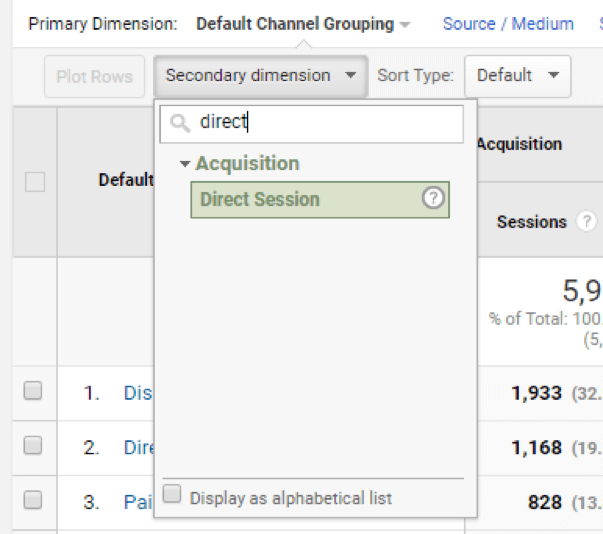Transform Your Analytics Method With Second Dimension in Google Analytics
By integrating second dimensions into information evaluation, a new layer of insights arises, shedding light on intricate customer habits and interactions. The strategic application of secondary measurements holds the crucial to unlocking a prize chest of indispensable details that can reinvent just how companies translate and act upon their information.
Comprehending Secondary Measurements in Google Analytics
Second dimensions in Google Analytics offer extra context to key data by enabling individuals to examine metrics throughout a second measurement, providing deeper understandings into individual actions and communications on an internet site. Secondary Dimension in Google Analytics. While key measurements give essential information factors such as pageviews, bounce price, and session period, additional measurements provide an even more in-depth sight by segmenting the primary data further. This segmentation permits customers to evaluate metrics in mix with one more dimension, such as traffic resources, demographics, or customer actions
Advantages of Using Secondary Dimensions
Making use of second measurements in Google Analytics supplies a critical advantage by improving the depth of analysis and offering an extra detailed understanding of user interactions and actions on an internet site. By including secondary dimensions, analysts can get useful understandings into the efficiency of certain sectors or variables within their information. This makes it possible for an extra thorough exam of individual behavior past surface-level metrics, enabling for a deeper expedition of the aspects affecting individual interaction and conversions.

How to Implement Second Measurements
When incorporating second dimensions in Google Analytics, one vital step is to pick the pertinent metrics and dimensions to enhance the analysis procedure. To implement second measurements efficiently, begin by accessing your Google Analytics account and navigating to the record you desire to enhance with additional information. Once in the report, situate the "Secondary Dimension" switch, usually discovered over the information table. Clicking on this switch will certainly open a drop-down menu listing numerous measurements that can be included to your key dimension for deeper understandings.
After picking the appropriate secondary measurement, such as 'Source/Medium' or 'Tool Classification,' Google Analytics will certainly display the data in an extra comprehensive layout, allowing you to cross-analyze different aspects of customer behavior. Bear in mind to try out different mixes of primary and additional measurements to uncover useful patterns and patterns that can inform your advertising and marketing methods. By executing secondary measurements attentively, you can get a more extensive understanding of your web look what i found site or application performance and make data-driven decisions to optimize your electronic visibility.
Analyzing Information With Second Dimensions
Enhance your information evaluation in Google Analytics by integrating second dimensions to delve much deeper right into user habits patterns and maximize your digital advertising and marketing strategies properly - Secondary Dimension in Google Analytics. By adding secondary dimensions to your primary data, you can get useful understandings that can help you make informed choices concerning your web site or application efficiency
Evaluating information with secondary dimensions allows you to segment your primary information additionally, giving an extra detailed sight of user communications. As an example, combining the primary dimension of 'source/medium' with a secondary measurement like 'landing web page' can disclose which certain web pages are driving website traffic from different sources. This information can be instrumental in refining your content approach or maximizing your marketing campaign to raise conversions.
Moreover, using second measurements enables you to recognize connections in between various metrics, assisting you recognize the influence of different variables on individual behavior. Whether it's examining demographics together with individual engagement metrics or tool groups with conversion rates, second measurements empower you to discover hidden patterns and patterns that can guide your advertising and marketing efforts.
Enhancing Performance With Second Measurements
To enhance the performance of data evaluation and decision-making in Google Analytics, including secondary measurements is essential to enhancing performance metrics and obtaining deeper insights into user actions patterns. By making use of secondary measurements, experts can delve beyond surface-level data and reveal important correlations that the original source may otherwise go unnoticed. This optimization method allows services to tailor their advertising initiatives extra successfully, determine locations for renovation in web site functionality, and enhance overall user experience.
Additional dimensions use a more comprehensive view of customer interactions by supplying added context to primary information metrics. For instance, combining the primary dimension of 'touchdown page' with a second dimension like 'device group' can reveal whether specific devices are most likely to drive interaction on specific landing web pages. This insight can educate responsive style renovations or targeted marketing approaches to improve performance.

Verdict
To conclude, the combination of second measurements in Google Analytics supplies organizations with a powerful tool to improve their analytics strategy. Secondary Dimension in Google Analytics. By diving deeper right into user actions and interactions, marketers can reveal important insights that can drive performance optimization and improve the general individual experience. Leveraging secondary dimensions permits a more detailed analysis of data, resulting in even more enlightened decision-making and customized advertising and marketing initiatives
Secondary dimensions in Google Analytics supply additional context to key information by enabling individuals to analyze metrics across a 2nd dimension, providing deeper understandings right into user actions and communications on a website. While primary measurements provide fundamental information points such as pageviews, bounce rate, and session duration, secondary dimensions provide an even more detailed sight by segmenting the primary information even more.One of the vital benefits of using secondary dimensions is the ability to uncover relationships and patterns that may not be instantly evident when assessing data with primary measurements alone.When including secondary measurements in Google Analytics, one necessary action is to pick the relevant metrics and measurements to enhance the evaluation procedure. Combining look at this web-site the key dimension of 'touchdown page' with a second measurement like 'device classification' can expose whether particular devices are much more likely to drive involvement on particular touchdown web pages.